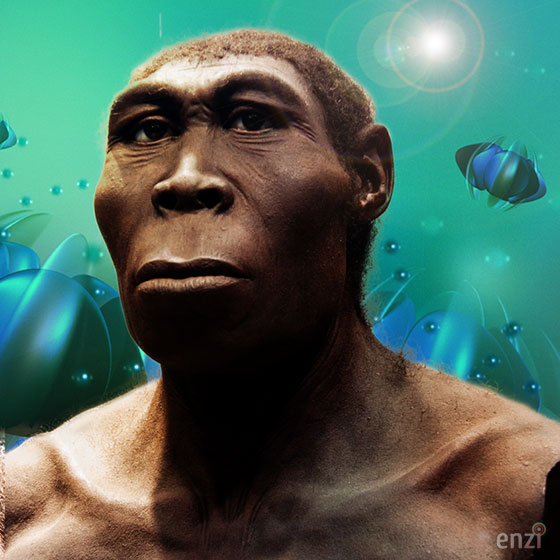Homo Ergaster & Homo Erectus
Homo ergaster and Homo erectus are sometimes used interchangeably. In some cases, ergaster is used to refer to an earlier, African ancestor of the later erectus which also lived in Asia.
Homo ergaster is an extinct species of Homo that lived in eastern and southern Africa from about 1.89 million years ago. Homo Ergaster is widely accepted to be the direct ancestor of later hominids such as Homo heidelbergensis, Homo sapiens, and Homo neanderthalensis rather than Asian Homo erectus. Homo ergaster possibly descended from, or shared a common ancestor with, Homo habilis.

Homo erectus
Homo erectus fossils have been found at Dmanisi in the Republic of Georgia (Western Asia) and in China and Indonesia where the species lived up until about 70,000 years ago.
“Ergaster”, is derived from the Ancient Greek word for “workman”, in reference to the comparatively advanced Acheulean technology developed by the species.
Many paleoanthropologists still debate the definition of H. ergaster and H. erectus as separate species. Some call H. ergaster the direct African ancestor of H. erectus, proposing that H. ergaster emigrated out of Africa and into Asia, branching into a distinct species. Many scientists dispense with the species-name ergaster, making no distinction between such fossils as the Turkana Boy and Peking Man. Though “Homo ergaster” has gained some acceptance as a valid taxon, H. ergaster and H. erectus are still usually defined as distinct African and Asian populations of the larger species H. erectus.
H. ergaster had a cranial capacity (700-900cm³ in earlier ergaster specimens, and 900-1100 in later specimens). It is estimated that H. ergaster stood between 4 ft 9 inches (145 cm) and 6 ft 2 inches ( 185 cm) tall. Their weight ranged from 88 – 150 lbs (40 – 68 kg). Remains have been found in Tanzania, Ethiopia, Kenya, and South Africa.
The earliest Homo erectus fossil discoveries were by Eugène Dubois, a Dutch surgeon in Java, Indonesia in 1891. There were later discoveries in China (Peking Man) beginning in the 1920s. Generally considered to have been the first species to have expanded beyond Africa, Homo erectus is a highly variable species, spread over two continents (it’s not certain whether it reached Europe). It is possibly the longest lived early human species – about nine times as long as our own species, Homo sapiens, has been around!
Early African Homo erectus fossils (sometimes called Homo ergaster) are the oldest known early humans to have possessed modern human-like body proportions . They had elongated legs and shorter arms compared to the size of the torso. These features are considered adaptations to a life lived on the ground, indicating the loss of earlier tree-climbing adaptations, with the ability to walk and possibly run long distances.
The most complete fossil individual of this species is known as the ‘Turkana Boy’ or ‘Nariokotome boy’. It is a well-preserved skeleton (though minus almost all the hand and foot bones), dated around 1.6 million years old. Microscopic study of the teeth indicates that he grew up at a growth rate similar to that of a great ape. There is fossil evidence that this species cared for old and weak individuals. The appearance of Homo erectus in the fossil record is often associated with the earliest handaxes, the first major innovation in stone tool technology.
In Kenya, you can view fossil and tool remains at Olorgesailie (about 70km from Nairobi on the road to Magadi) and Kariandusi (about 120km from Nairobi on the road to Nakuru).
H. erectus coexisted in East Africa with several other early human species including Homo rudolfensis, Homo habilis, and Paranthropus boisei. Sometimes they were even found at the same fossil sites. At the end of its time range, around 70,000 years ago, it coexisted with Homo floresiensis and possibly Homo sapiens in Indonesia.
The tall bodies and large brains of Homo erectus individuals required a lot of energy on a regular basis to function. Eating meat and other types of protein that could be quickly digested made it possible to absorb nutrients with a shorter digestive tract, making more energy available faster. It is possible that honey and underground tubers may have been significant food sources for Homo erectus.
Homo ergaster is considered the innovator of the Acheulean stone tool industry which consisted of the creation of large cutting tools like hand axes and cleavers. Increased reliance on a broader set of tools may have helped Homo erectus survive during changing climates.
The earliest evidence of campfires occur during the time range of Homo erectus. While there is evidence that hearths were used for cooking (and probably sharing) food, they are likely to have been places for social interaction, and also used for warmth and to keep away large predators.
Though it was thought for a long time that H. ergaster was restricted in the physical ability to regulate breathing and produce complex sounds, Homo ergaster was probably the first hominid to “use a human voice”, though its symbolic cognition was probably somewhat limited compared to modern humans. There is no archaeological evidence that Homo ergaster made use of symbolic thought (such as figurative art), but the well-evolved brain and physical capabilities (along with reconfiguration of ergaster’s breathing-apparatus) suggest some form of linguistic or symbolic communication.
